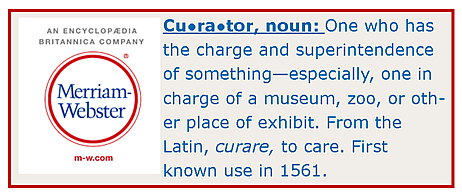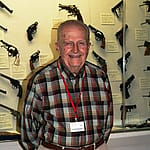
Curators: Not just for museums anymore
“Hello, may I speak to the Curator, please?” Here at the Buffalo Bill Center of the West, we often get calls from folks who ask that question. But, we have five museums; hence, we have five curators—one for each section. (Actually, we now have six curators as we have a curator of public history, too.)
A classic view of curators is that quiet, content specialist in a white lab coat, wearing thick glasses, and using a plastic pocket protector. His job was to gather and care for cool stuff within his area of expertise. However, that museum professional today doesn’t just oversee a particular collection, but she is an interpreter, educator, and historian to place an object properly in context of people, time, and place.
But hold on: Curators aren’t just for museums any more. I conducted an online search with the word “curator,” and discovered all kinds of entities and products adopting the term:
- Curator is a visual notes pad for iPad.
- Curator is a PR agency in Seattle.
- Biocurators are professional scientists who curate, collect, annotate, and validate information disseminated by biological and model organism databases. – and –
- The Curator is a World of Warcraft (online game) character—an “arcane guardian boss whom players must defeat at Karazhan to get to other bosses”!
Even the digital world now has curators. Who knew that those of us in public relations would eventually become curators, too? “Curating content” is the buzzword for us today.
Content curation is the act of discovering, gathering, and presenting digital content that surrounds specific subject matter,” says Eileen Mulan from econtentmag.com. “[A] content curator is not necessarily responsible for creating new content [although in a museum setting, we never lack for content!], but instead, for finding relevant content pertaining to a specific category and funneling this information to readers in a ‘mash-up style.”
To be sure, curators are cropping up in many different environments these days. But, thankfully, our traditional content experts here at the Buffalo Bill Center of the West lend attributes that make for first-class curators: authority and authenticity. So, if you were a curator, where would your expertise be? Post your thoughts here!
Our curators in 2014: Top, L–R, Jeremy Johnston – Buffalo Bill Museum; Rebecca West – Plains Indian Museum [Acting Curator]; Charles R. “Chuck” Preston – Draper Natural History Museum; Mindy Besaw – Whitney Western Art Museum. Bottom, L–R, Warren Newman – Cody Firearms Museum; and John Rumm – Curator of Public History
Written By
Marguerite House
Marguerite House served as the Center of the West’s Acting Director of Public Relations until her retirement at the end of 2018, and as editor of its member magazine, Points West, through May 2019. Following a seven-year stint as Business Manager for the Cody Country Chamber of Commerce, Marguerite moved “across the street” to the Center in 1999. She then held five different positions in three of the Center’s four divisions, landing in PR in 2005. “I think that [gave] me all kinds of perspectives for our readers,” she says. She enjoys writing (especially a weekly column for the local newspaper called “On the House”), cooking, and spending time with her six grandkids.


















